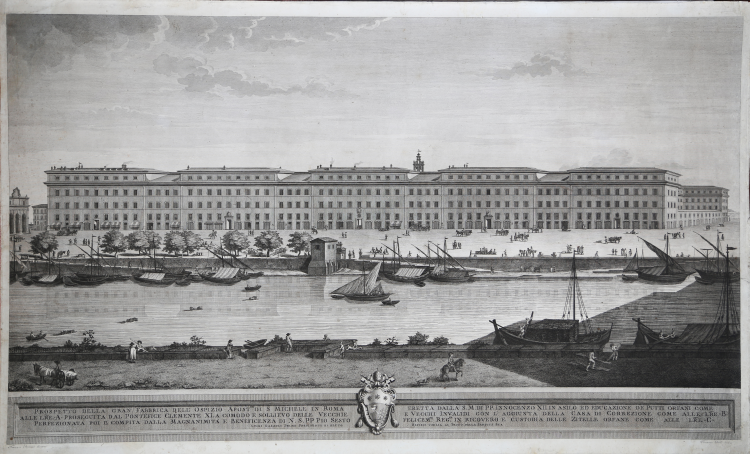



| Reference: | S40560 |
| Author | Vincenzo FEOLI |
| Year: | 1796 ca. |
| Zone: | San Michele a Ripa |
| Printed: | Rome |
| Measures: | 990 x 600 mm |


| Reference: | S40560 |
| Author | Vincenzo FEOLI |
| Year: | 1796 ca. |
| Zone: | San Michele a Ripa |
| Printed: | Rome |
| Measures: | 990 x 600 mm |
Etching, 1796 circa, at bottom caption on three lines separated at center by the heraldic coat of arms of Pius VI. Signed below the image: “Francesco Pannini disegnò” e “Vincenzo Feoli incise”.
Inscribed: PROSPETTO DELLA GRAN FABBRICA DELL’OSPIZIO APOST.CO DI S. MICHELE IN ROMA ERETTA DALLA S.M. DI PP. INNOCENZO XII IN ASILO ED EDUCAZIONE DE’ PUTTI ORFANI COME/ ALLE L[ETTE]RE =A= PROSEGUITA DAL PONTEFICE CLEMENTE XI A COMODO E SOLLIEVO DELLE VECCHIE E VECCHU INVALIDI CON L’AGGIUNTA DELLA CASA DI CORREZIONE COME ALLE L[ETTE]RE =B=/ PERFEZIONATA POI E COMPITA DALLA MAGNAMINITà E BENEFICENZA DI N.S. PP PIO SESTO FELICEME.TE REG.TE IN RICOVERO E CUSTODIA DELLE ZITELLE ORFANE COME ALLE L[ETTE]RE =C= /LUIGI GAZZOLI PRIMO PRESIDENTE IN DETTO OSPIZIO UMILIA AL TRONO DELLA SANTITà SUA.
Engraved by Vincenzo Feoli after a 1794 drawing by Francesco Pannini made on the occasion of the completion of the buildings added at the behest of Pius VI.
Occasional foxing, otherwise in very good condition.
“L'acquaforte del Feoli descrive con rigore topografico l'ampia veduta, definendo la diversa intensità luminosa della superficie architettonica e dell'acqua del fiume sottostante, mentre il bulino disegna i contorni più mobili e frastagliati della vegetazione, delle imbarcazioni e delle scene di genere che popolano l'immagine (Arrigoni-Bertarelli, 1939, n. 2002; Il Settecento a Roma, 1959, p. 253, n. 1080; Piranesi e la veduta del Settecento a Roma [catal.], Roma 1989, p. 95; un esemplare del Gabinetto comunale delle stampe di Roma, MR 40650, riporta a penna la data 1796)” (Rossella Leone - Dizionario Biografico degli Italiani - Volume 46 (1996), “Vincenzo Feoli”).
According to President de Brosses, a French traveller who visited Rome in 1739, beggars amounted to a quarter of the population; maybe his assessment was not based on accurate research, but certainly pauperism, the state of being poor and relying on charitable assistance for living, was a normal condition for a significant part of the population of Rome. The city attracted poor people from the countryside and the many institutions founded by the popes to tackle pauperism in a way caused its growth.
In 1686 Carlo Tommaso Odescalchi, a relative of Pope Innocent XI, felt that a partial solution could be found in teaching a job to the abandoned male children of the poor; he bought a piece of land near Porto di Ripa Grande and by 1689 a building was completed (probably designed by Mattia de' Rossi); it was located in the second from the left of the five identical blocks which make up today's Ospizio di S. Michele. In 1693 Pope Innocent XII bought the charitable institution and commissioned Carlo Fontana to enlarge the existing building; Fontana added another storey to it and built two identical blocks at its sides; a fourth block was completed by 1714. The new complex housed in separate sections also old people and unmarried women. The boys worked in a wool factory, but also a printing press was installed in the premises reserved to them. Fontana built also a large church inside one of the blocks; its bells can be seen from the outside.
Vincenzo FEOLI (Roma, 1760 c. – Roma, 1831)
|
He was born in Rome perhaps around 1760, although some repertories indicate about 1750 as the date of his birth (Petrucci, 1953, p. 59; Servolini, 1955), considering that there is no news of his works prior to the early nineties of the eighteenth century, it seems unlikely that he appeared on the Roman chalcographic market only at the age of forty years.
A rich production of him survives, indicating his gradual specialization as a translator of architectural, archaeological and topographical drawings. His professional skill was probably widely recognized in Rome in those decades if Feoli was entrusted with the engravings for the illustrative tables of the most prestigious publishing initiatives of the time.
We don't know exactly the scope of his training, although his engraving technique is influenced by the refined, but dry and didactic language, suitable for documentary description, that the Roman school developed in the last decades of the century, bending the virtuosity of the etching and the burin, popularized by Venetians and Bassanesi and marked by the unique Piranesi's elaboration, to the promotional needs of the antiquarian market and the celebratory ones of the various pontificates.
|
Vincenzo FEOLI (Roma, 1760 c. – Roma, 1831)
|
He was born in Rome perhaps around 1760, although some repertories indicate about 1750 as the date of his birth (Petrucci, 1953, p. 59; Servolini, 1955), considering that there is no news of his works prior to the early nineties of the eighteenth century, it seems unlikely that he appeared on the Roman chalcographic market only at the age of forty years.
A rich production of him survives, indicating his gradual specialization as a translator of architectural, archaeological and topographical drawings. His professional skill was probably widely recognized in Rome in those decades if Feoli was entrusted with the engravings for the illustrative tables of the most prestigious publishing initiatives of the time.
We don't know exactly the scope of his training, although his engraving technique is influenced by the refined, but dry and didactic language, suitable for documentary description, that the Roman school developed in the last decades of the century, bending the virtuosity of the etching and the burin, popularized by Venetians and Bassanesi and marked by the unique Piranesi's elaboration, to the promotional needs of the antiquarian market and the celebratory ones of the various pontificates.
|